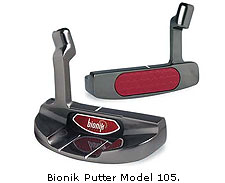What putter will work for me?
Staff Report

When making a decision to purchase a new complete set of golf clubs, most golfers spend the majority of their time researching and analyzing information about woods and irons. Customers often overlook the importance of finding the correct putter. It is a well known fact that most golfers add unnecessary strokes to their game while on the putting green. We feel those strokes can be easily avoided or at least minimized.
If you are having trouble reaching a specific benchmark in your game, putting is an area in everyone's game that needs to be improved. The right putter can make a huge difference, whether it is trying to break 100 or 80. We feel it is important to research to find an effective putter for you.
All of us have grabbed a putter and instantly knew it felt good after a few practice swings. The first impression you get when you use a new putter is an important test that tells you what type of look and feel appeals to you. You want something in your hands that gives you the confidence of making the putt before you even hit the ball.
Here is a simple checklist we go over with our customers to help them decide on a putter. Of course there are numerous considerations; we try to point out the obvious to make the decision easier for you.
Decide on a putter head shape design.
Determine what alignment system is going to help you visualize the line you are seeking.
Insert or No Insert? What type of feel at impact feels good to you?
We have categorized putter head shapes into three different styles: cavity back, blade and mallet/half moon.
Cavity back putters are traditional looking putters with a hollowed area in the middle back of the face of the putter, which generates a larger sweet spot. The focus of the weight is distributed toward the perimeter of the putter head. The classic cavity backed putter would be the Ping Anser putter, first popularized in the early 70s.
Blade style putters have the weight of the club head distributed to the heel of the face, leaving you a thin top line to look at when you are addressing the ball. The Titleist Bullseye would be a great example of a popular blade putter.
Mallet putters are much bigger than "traditional putters" with alignment systems incorporated into most new models. The shape of the putter head tends to be bigger and there are numerous variations of the head shape. Half moon putters are similar to mallets, but with a rounded head shape. The Odyssey Two-ball putter is one of the hottest mallet putters on the market today.
There are various types of alignment systems available in putters. It can be difficult to decide which one to choose; golfers should base their decision on what feels most comfortable.
To make your decision easier, determine what visual aid helps you line up a putt. For example, a line, ball or double lines all assist your putting strategy. We don't think one system is better than the other, which is why you see so many variations of putters used on the course. They all have one goal which is to aid you in lining up your putt.
What is the purpose of the insert in the putter? There is a reason why it is located in the sweet spot of the putter. Various inserts will provide different results. Some inserts are soft, some hard and some are milled so the surface if completely "flat".
They also reduce skipping at impact an important feature to make sure your putt stays align. The main purpose of an insert if to provide specific feel to the individual golfer and depending on what feel you are looking for will determine if a inserts will fit you.
As you can see, there are many types of putters available, all with different looks and feels. The most important factor is to get a putter that feels comfortable when you address the ball in your putting stance. You want to do everything possible to give you the confidence that you will make every putt.